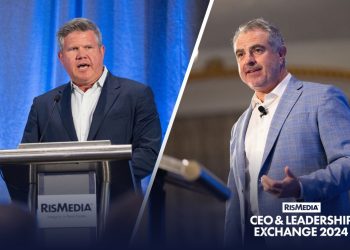
RISMEDIA, June 17, 2008-Targeting consumers, or dividing them into subsets that are emerging or underserved, may be one of the best ways to grow profitability and reach consumers in today’s market. But first, you should know who’s in your backyard. Whether you are seeking to serve teachers, Hispanics, or young first-time home buyers, your sales associates and brokers should have a clear understanding of their local market.
Moderator:
Alex Perriello, Special Liaison for Large Firm Relations, NAR
Participants:
Rich Rector, President & CEO, Realty Executives International-Phoenix, Arizona
Ed Krafchow, President & Co-Owner, Prudential CA/NV/TX Realty-San Francisco, California
Raymond Morris, Broker/Owner, RE/MAX Greater Atlanta-Atlanta, Georgia
The Power Broker Roundtable is brought to you by the National Association of REALTORS® and Alex Perriello, NAR’s Special Liaison for Large Firm Relations. Watch for this column each month, where we will address broker issues, concerns and milestones.
 Alex Perriello: Targeting consumers, or dividing them into subsets that are emerging or underserved, may be one of the best ways to grow profitability and reach consumers in today’s market. But first, you should know who’s in your backyard. Whether you are seeking to serve teachers, Hispanics, or young first-time home buyers, your sales associates and brokers should have a clear understanding of their local market. This, according to the experts, breeds success, making it easier to reach new buyers and sellers.
Alex Perriello: Targeting consumers, or dividing them into subsets that are emerging or underserved, may be one of the best ways to grow profitability and reach consumers in today’s market. But first, you should know who’s in your backyard. Whether you are seeking to serve teachers, Hispanics, or young first-time home buyers, your sales associates and brokers should have a clear understanding of their local market. This, according to the experts, breeds success, making it easier to reach new buyers and sellers.
AP: How is your marketing evolving to meet new consumer segments?
Rich Rector: In recent years, we have spent time and resources identifying consumer segments that need greater focus. For instance, with the creation of Realty Executives’ Homeworks, a marketing program that meets the housing needs of teachers and others in education, our sales associates are able to increase their bottom lines while also helping a group that may have some difficulty attaining homeownership. Also, over the last year, we’ve engaged one of our experienced and knowledgeable sales associates to research and develop a program that speaks directly to the needs of today’s Latino professional.
 Ed Krafchow: We’re providing a push toward much more localized advertising to help agents reach their market. Second, the next upturn will come from people either using English as a second language or with those who are recent immigrants. We’ve created a magazine called Palacio to reach this market and truly educate people about the housing market. Third, the consumer is looking for a more fulfilling search experience, one that involves context over content. Consumers will, through 3D imagery on the Internet, see what the house looks like or what a street looks like from different angles. We’ll be able to offer this on our website in the next six months.
Ed Krafchow: We’re providing a push toward much more localized advertising to help agents reach their market. Second, the next upturn will come from people either using English as a second language or with those who are recent immigrants. We’ve created a magazine called Palacio to reach this market and truly educate people about the housing market. Third, the consumer is looking for a more fulfilling search experience, one that involves context over content. Consumers will, through 3D imagery on the Internet, see what the house looks like or what a street looks like from different angles. We’ll be able to offer this on our website in the next six months.
 Raymond Morris: We’re working to have our website in both English and Spanish. We’re planning to have a cleaner layout, easier navigation, and a better interface for saving properties and search results. And we’re adding map searches with subdivision details. Consumers can now save and create their own shopping cart for homes and later revisit our website to continue shopping. Other developments include working diligently to help consumers with alternative financing, such as FHA, and working through our agents to promote NAR’s Public Awareness Campaign, “It’s a Great Time to Buy a Home.”
Raymond Morris: We’re working to have our website in both English and Spanish. We’re planning to have a cleaner layout, easier navigation, and a better interface for saving properties and search results. And we’re adding map searches with subdivision details. Consumers can now save and create their own shopping cart for homes and later revisit our website to continue shopping. Other developments include working diligently to help consumers with alternative financing, such as FHA, and working through our agents to promote NAR’s Public Awareness Campaign, “It’s a Great Time to Buy a Home.”
AP: What major challenges are you facing as you embark down this road?
RR: One of our biggest challenges is simply educating our productive real estate professionals and the consumer. Because we know our success lies in the proper execution and delivery of these valuable programs, we’re dedicated to ensuring that all of our meetings, communications, and marketing drive adoption and education.
EK: I’m pleased with how the industry has become more and more understanding of technology and the Internet. In an up market, there wasn’t much interest. We tended to rely on newspapers to disseminate information and go after customers. Now the flow has gone the other way.
RM: Our biggest challenges are the media, convincing the consumer this is a good time to buy, and keeping our agents both positive and focused.
AP: How has segmentation helped to grow the company’s profitability?
RR: The programs that I’ve described are able to immediately and positively impact the profitability of our sales associates on the “front lines.”
EK: I believe that segmentation will lead to higher service, and profit will be a by-product of that service.
RM: We continue to focus on profitability by helping our associates with their production through our website, through extensive training, and through our joint venture with Wells Fargo. RE










